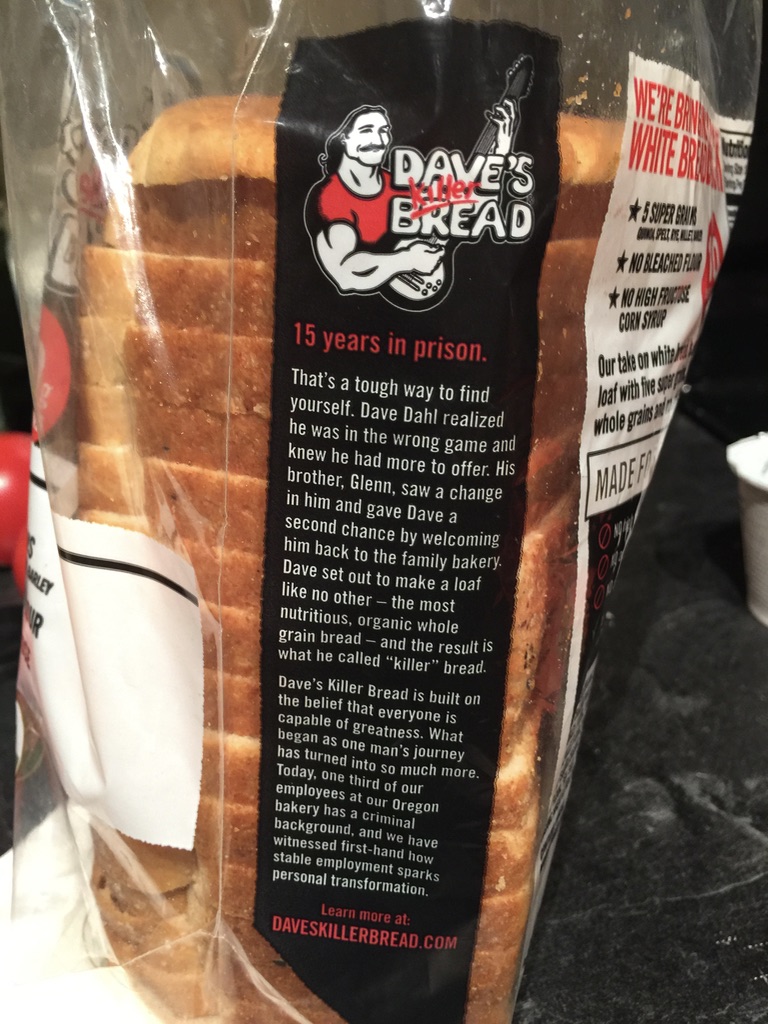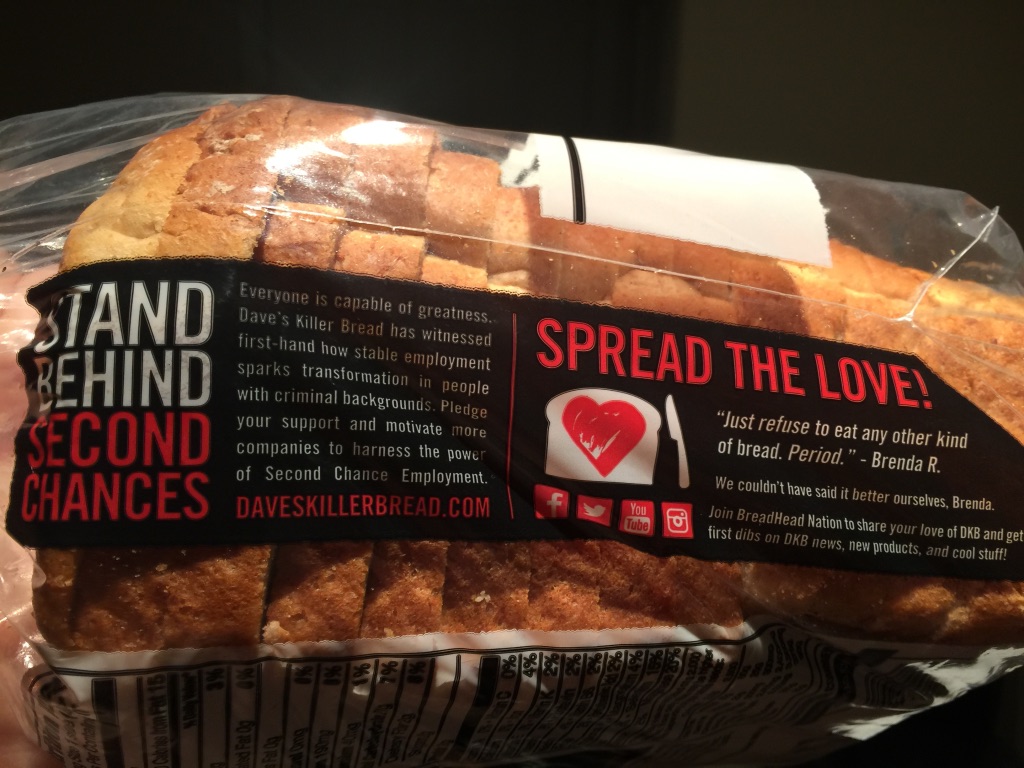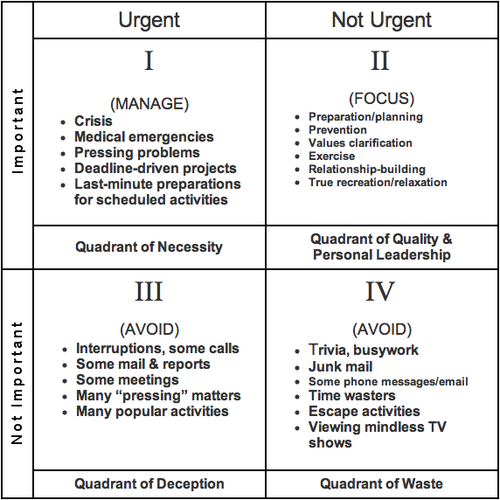Is it OK to expose your own flaws in business?
Many folks I speak with insist on their business being a superhero with no flaws to speak of.
They are always on-time, on-target, mobile, social, and with the best customer service of all time.
It’s hard to connect with something like that. The invincible nameless faceless entity.
Sometimes, connecting with customers on an emotional level requires opening up about your own mistakes.
I discovered Dave’s Killer Bread in our pantry this morning.

Who is Dave?

Dave has a story. But his and his brothers’ story are what drives the mission of Dave’s Killer Bread.

This mission seems like a noble one, and one that I can get behind — importantly though, there are many folks that might not get behind it at all.
You never know who you will connect with. My wife doesn’t typically bring ex-cons into our home, but she is a compassionate person. This bread connected with her. She mentioned that she could really get behind that and planned to continue to buy Dave’s.
Sometimes you have to choose who your customers are and invite them in. You may find that while some will vehemently reject the invitation, there are likely a lot more that will accept it.
It’s when you get no RSVP at all that you may be doing something wrong. Your message may not be striking any emotional response at all — and that’s the worst place to be.
Is it time to lift my personal boycott on Walmart?
I've been avoiding shopping at Walmart for years.
Years.
Part of the reason has been that I hate to see employees treated like they don’t matter. Walmart has been one of the biggest offenders in my opinion.
What if paying workers more, training them better and offering better opportunities for advancement can actually make a company more profitable, rather than less?
They kept wages down, limited hours to avoid being obliged to provide benefits, and would cut people early like it was a slow lunch shift at a seafood restaurant. Except in this case, the employees didn’t have a chance to make their own tips.
The left brain in me though had admired Walmart’s operations management and extremely efficient way of doing business.
For example, Walmart runs their own weather center to predict needs in the market, and help route logistics. Their swift response in many natural disasters bests FEMA because they have the real-time data and the ability to act fast.
The efficient use of resources is admirable when it means making the best and most cost-effective use of machines, and other resource inputs to make the operation run smoother. When it becomes deplorable, is when Human resources are treated in the same way.
It looks like there may be hope for Walmart yet.
The following snippets are from an article in the New York Times
How Did Walmart Get Cleaner Stores and Higher Sales? It Paid Its People More
A couple of years ago, Walmart, which once built its entire branding around a big yellow smiley face, was creating more than its share of frowns.
Shoppers were fed up. They complained of dirty bathrooms, empty shelves, endless checkout lines and impossible-to-find employees. Only 16 percent of stores were meeting the company’s customer service goals.
But in early 2015, Walmart announced it would actually pay its workers more.
That set in motion the biggest test imaginable of a basic argument that has consumed ivory-tower economists, union-hall organizers and corporate executives for years on end: What if paying workers more, training them better and offering better opportunities for advancement can actually make a company more profitable, rather than less?
Read the full story on how Walmart has been changing their model here:
http://nytimes.com/2016/10/16/upshot/how-did-walmart-get-cleaner-stores-and-higher-sales-it-paid-its-people-more.html
We’re BOTH so demonstrably excited WE can barely contain OURSELVES. #harpershashtag

Experience - Practice Makes Know-how
It's easy to read something in a book and call it knowledge; but only when you get your feet wet trying it can you really know it well.
I’ve been thinking a lot lately about what it means to experience something.
It isn’t ever quite like what you thought it’d be. There are always a few surprises.
For example, I remember seeing a client in person for the first time recently (we’d only previously video-conferenced). I hadn’t expected him to be as tall.
But it’s more than appearance. It’s how something is going to be. Have you ever done something new that you had been nervous about and thought, “That wasn’t so hard” or the opposite?
"Of the three ways in which men think that they acquire knowledge of things—authority, reasoning, and experience—only the last is effective and able to bring peace to the intellect." (Roger Bacon, English philosopher and a major progenitor of modern science.
Over the years, I have gained a completely different outlook on my own profession. I feel like I have a few things figured out that I can’t quite put into words, yet. I’m working on that…
The point is that I can remember a time many years ago when I went out and hung a shingle and told myself that I had to figure it out as I went along.
I’m still doing that. And I’m never going “figure it out” but, I’ll tell you I learn what not to do along the way and that helps me build up my know-how. I wouldn’t be as far along on my never-ending journey to self-actualization as I am if I had never gotten started.
You can always count on learning something when you actually jump in. If you are waiting on something to happen before you take a leap in your life, don’t. Jump in with both feet and you just might learn something.
Is email dead for communication in favor of chat/texting apps?
My friend, John, asked this question on Facebook:
Let's talk about email. Is it dead? Why would anyone use it for official communication? Marketing? Sure. But official stuff? No way. What will replace it? Coffee shop chats? Love that idea.
I was provoked to think about this question; my wheels got turning, and I wrote a reply. I’ll share that with you here now:
?
I don’t think email is dead John, as I think it’s It’s the fastest way to share an attachment or a link with someone at another company.
There’s no qualifier needed to understand if they are on iOS or android, or another slack team to join. And texting/iMessage isn’t great for sharing docs and especially links meant to be consumed on a desktop.
Email is kind of a universal post office replacement for information/doc sharing.
But… I think the greater point you are getting to is that we need more face to face. I think we don’t pick up the phone enough and call people in favor of text/email.
We don’t get in front of people often enough to actually catch up. And if you believe what the loud folks keep say about millennials ; they have lost the physical ability to speak and only communicate through emoji. I don’t think it’s gone that far, but it’s definitely worse than it used to be.
I’m on the older side of that spectrum in the “official age range” of millennial and I haven’t lost my ability to speak on the phone, but definitely default more than I should to a quick text based message. I need to work on that.
?
So that's it?
I need to work on my communication skills when it comes to reaching out to people either on the phone or face to face.
Am I hiding behind the asyncronicity of email, text and everything besides speaking directly with that other person?
I might actually be.
The convenience and performance enhancing factors of using tools like Slack to move things along when getting work done, and to get quick answers are unmistakeable. But sometimes you have to get on the horn or in front of a whiteboard and hash it out.
But I know that there are times that I know that should, that I haven’t picked up the phone or made the face to face.
And I think that this is why so many “millennials” get a bad rap. They (we? You be never thought about myself as being in that category, but I think I may be wrong) don’t see the total eschew of phone and meetings as different.
Young Dogs, New Tricks
If we are talking about how to navigate within a team; what we have is a couple of extremes; and when everyone can meet closer to the middle and give a little, it all seems to work out much better.
It’s when you have old dogs and young dogs both unwilling to learn new tricks that the worst kind of conflict and resentment build within a team.
It’s up to you/me/us to be willing to learn the new tricks and accept that many folks come from different places. We have to assimilate and be a team.
If you have an opinion on this: Email me. Or call me, or WhatsApp me, or we’ll have coffee. At this point, I’ve decided I’m game for whatever.
For real though... stop pitching over email
As a leader in a marketing oriented firm, I get a whole lot of cold email.
I’ve talked about this before, but it’s worth highlighting again today.
Pete posted an article yesterday that (among other things) included the titular advice, “Stop pitching over email.”
Too many salespeople prematurely pitch over email. They describe the features and benefits of their products and services, what they do and how they do it. As should be evident by the low response rate these types of emails get, their pitch is falling on deaf ears.
So that’s the problem…
But what should you, salesperson, do instead? It ain’t that difficult folks. Caputa goes on in his article to say:
What should you do instead? Determine whether a prospect has a need before pitching anything.
Is there a better way to determine need?
So you may have decided that email isn’t the best way to start, and be asking if this means you should be diagnosing pain on the first phone call…
Well, hold the phone partner…
I have personally spent this week with some really smart people in the sales profession.
One of them, had something like this to say about the first step of the sales process: “The only objective when you first connect with a prospect (in this context; inbound or outbound) is to establish a real and meaningful connection with that person. If you can’t do that, it isn’t worth pitching anything.”
My Grandmother Rule
or How to Stop Worrying and Love Social Media and the Fact That Nothing We Say Is Ever Private
I often speak with folks who are afraid of social media. They are afraid people will say bad things about them or share bad things or leave bad comments.
My take on this, is that if you run your business as if your Grandmother were in the room; you should have nothing to fear.
You can't control others behavior, you can only control yourself. If a man on a bus says lewd remarks to you about women outside, you can either participate, or decide to not participate. It's up to you. But do assume that your choice will end up on the national news one day.
I approach social media and business situations (and life for the most part) as if my grandmother were in the room. I was taught "Yes sir, No Ma'am" type chivalry and do not consider it a burden to hold the door open for people.
I also try my damndest to stay out of disparaging conversations unless something really needs to be stood up for. Because it is important to be polite in most cases.
Though I can be direct, I try not to be hurtful or rude. Businesses who can take a similar course have nothing to fear on social media.
Hi Grandmother! Thanks for the chicken dinner the other night.
Are your managers halting innovation in favor of inner office politics?
Oliver Hart of Harvard split this year’s Nobel Prize in economics for his work on incomplete contracts.
Imagine an inventor who needs to distribute a new product. Success will probably ride more on the inventor’s choices than on distribution. So it makes sense for the inventor to have the power to make the big decisions. The way to do that is for the inventor to be what economists call the “residual claimant.” That is, the inventor has the rights not only to the invention but also to the distribution channels.
What happens in a company when the managers do not have the incentive for overall firm success, but rather are rewarded on things like profits?
I’ve seen many folks in these positions focus so much on the short term that they often miss opportunities to gain traction by taking a leap that might require a temporary stall in operations or retooling of something internal.
Sometimes you have to give the machine a tuneup or even buy a new machine, and if managers aren’t incentivized in the right way, they can “leave that worry for the next person” who will fill that role and let an opportunity to leap forward pass them by.
All employees at the Ritz-Carlton are famously empowered to spend up to $2000 without managerial approval to solve a problem.
Can we apply this same thinking to innovation? I’ve worked with many companies where employees and managers have great intuition in marketing, but never float the necessary ideas to the top in favor of politics and “picking battles”.
If you are at the top, I implore you to design compensation around encouraging successful innovation; and encourage everyone to speak up when they have these intuitions.
The culture of “They’ll never approve this.” Is of your own making. It’s yours to unmake.
When you get home and everybody’s already fast asleep. Except for Lambie. #HanginwithLambie

Helps customers buy, so they can do some selling for you
Marketers and salespeople get a bad rap sometimes. It's mostly from folks who have had a bad experience.
But most people I speak to can recall far more positive commercial experiences than negative ones when really asked to consider this.
I think it is because the bad experiences stereotype are just hard to forget and the satisfactory ones that meet our expectations are easy to forget.
That doesn’t make it any easier to produce a pleasant buying experience. It’s hard. You have to really think about how the consumer wants to interact with you, your product and the purchase process.
You have to make sure your people are properly trained and in the same page.
Consistency and ease of purchase are the building blocks of success
You have to try to keep each experience consistent from one to the next.
The continued success of McDonald’s is not built on quality of the product; it is built on consistency in product and purchase experience.
“Marketing in an interactive world is a collaborative activity—with the marketer helping the consumer to buy and the consumer helping the marketer to sell.” - Seth Godin
You can’t expect the consumer to help you sell through word of mouth referrals (or even incentives) if they have to qualify the recommendation with: “It’s kind of a hassle”, or “For the most part, you get what you came for.”
Helps customers buy, and they can do some of the selling for you. You can’t quite get rid of your sales staff, but if you want word of mouth referrals, you need to focus on these fundamentals.
Are you making it hard for your customers to buy?
Have you had your customer stand in front of you, card in hand, and not allowed them to buy?
There’s an annual art festival in my neighborhood. It has gotten huge over the years.
Folks from around North Texas flock to a closed off thoroughfare and peruse art, listen to live music, eat food from trucks, and sip on wine in the streets.
We took our little family out there, as we like to do, yesterday. It really was a blast. My daughter of 19 months downed an entire gyro and danced.
I noticed some troubling things about vendors, though.
One of the fundamental things that this event is.. is an art show. Vendors sign up to come to things like this to show their art. Many come from very far away in the hopes that some of that art will be purchased.
They spend time putting together elaborate displays, and spend many hours in the hot sun engaging with customers.
But… it seemed about half of these folks forgot to think about how buyers buy.
We should all look at the following as a case study and reflect on whether or not we are adding any unnecessary friction to our own customer’s buying process.
If you have a price tag of $300+ on your artwork, and you are cash only… you might have a disconnect with reality. Who carries that much cash?
“Check” is not always a great second option. When I put together my camelback, sunscreen, keys, extra bottled water, and diaper bag for the arts festival…. checkbook is not typically a part of that essentials checklist.
I should really remove the 300+ qualifier. I don’t carry that much cash these days. It’s pretty much a card only society at this point. Food truck vendors know this. They all have those little phone credit card swipers and are ready to trade you a swipe for as many tacos (or vegan meat patties? i saw a truck for this. count me out.) as you can handle.
With all the effort that the art vendors and artists put into the production of showing up, they should really look into the free option of ordering a reader from somewhere like Square. These kind of processors take a fixed percentage of each sale and no monthly fee. They even send you a free little swiper to plug into your phone.
[caption id=“attachment_237” align=“aligncenter” width=“700”] I’m not stumping for Square here. Just showing how easy it is. There are many similar options.[/caption]
I’m not stumping for Square here. Just showing how easy it is. There are many similar options.[/caption]
I’ve heard some objections to this in other environments about the percentage. I usually use 3% as a rule when thinking about this variable cost of doing business.
It’s a question you should ask yourself: Is 97% of something better than 100% of nothing? What hassle are you trying to save yourself that making it harder on your customer? Should you accept a burden to enable the sale?
I did see another issue with some of the artists I’ll talk about in another post. Engagement. I’ll link that here when it’s posted.
Priorities
Last week, I realized I had bit off more than I could chew.
I had put one (probably more than that) too many things on my plate and had to let one go.
I looked up and realized that there was one “urgent” obligation that was completely voluntary, optional, and not important.
It reminded me that I need to step back and assess things every now and then.

By dropping that task and staying closer to the II quadrant, I was able to gain a bit of sanity back, and spend a little bit more quality time with my daughter.
She rode a pony, and I might have missed it otherwise.
“There is so much bad in the world… and then there is Harper.” - @handybethany on #harpershashtag

This pony’s name is Cowboy. #harpershashtag

Say it with fewer, simpler words when possible.
Essential tips on writing for clarity.
This is an email I received from one of my Professors in my MBA program. I now share this with you.
Single space between sentences. Back in the old days you double spaced on typewriters, but printers now adjust for periods so only one space is needed.
Edit down, edit down.
Typical problem is verbosity. When you edit, read a couple times just thinking about sentence structure itself–not the substantive content.
Say it with fewer, simpler words when possible. Delete needless verbiage. Hemingway is an example of a great writer–short simple sentences with simple language.
Paragraphs tend to be too long. People are put off by that. Paragraphs should begin with a simple sentence that lets the reader know what the paragraph is about.
Delete needless adjectives. The word “very” should almost never be used.
Is the content organized properly? If you say you are going to cover something, does it get covered?
When you read yourself for substance, then just think about the content, ignoring the English. Is it organized logically and get the key points across?
As I noted, you should use the WSJ (Wall Street Journal) as a guide for level of explanation and how to make a topic a bit more interesting to a reader.
Editing for clarity and content is noticed by the reader. Lots of smart people never go anywhere because they cannot tell others clearly what they know, so it is a skill worth developing.
Best,
RM
I hope you found as much value in these words as I did.
The “Field of Dreams” Fallacy and Inbound Marketing Myths
If you build it, they may not even know… Are you waiting on Shoeless Joe?
Are you taking the “Field of Dreams” approach to inbound or content marketing? Many folks I speak to are… and it’s killing them.
I have to tell you, it frustrates me to see folks working hard to create some content, and then no one ever sees it.
Often, this lack of “splash” is that makes quitters out of some really otherwise tenacious people.
Well, Im here to tell you that you can’t just publish an article on your website and expect that people are going to:
- know about it.
- care enough to read it.
- care enough to “like” it on Facebook.
- care enough to comment on it.
- care enough to share it.
- be moved enough to take action.
If you aren’t getting the response you had hoped for, ask yourself: Is there a chance I didn’t ask for that response? In many cases, people will do what we ask.
I’ve seen people’s feelings hurt when their stuff didn’t get found, but they didn’t spend the time to promote it themselves.
I’ll ask:
Did you email it to your group of close advisors? Did you even share it on LinkedIn? I usually don’t even need to ask whether or not there was a promotion strategy in place.
There are a lot of times when content can be found in Google searches if you are truly trying to serve the customer (more on that in a future article, maybe this weekend. I’ll link it here when it is done). But you can’t count on that, especially in the beginning, because it takes time to show up there for certain phrases.
So start focusing on how to get your stuff seen as you create it. For more on that, here’s a selection from Jay Baer’s piece on marketing your marketing.
They marketed their marketing. You have to consider that when you’re attempting to break through the enormous amount of digital clutter, and it’s where social media and content really work together.We often think about content and social media as different, but they are really two sides of the same coin. Content is fire, and social media is gasoline. It’s much easier (and more effective in many cases) to use social media to promote outstanding content, than it is to promote your company.
Read the rest of Jay Baer’s piece here:
www.convinceandconvert.com/content-m…
Does your business communication sound like a human speaking?
It might be time to stop pretending that your business was built by some kind of brand entity without flaws.
If your website reads like a robot wrote it, no one is likely to “connect with your brand” in a meaningful way.
I read an article yesterday about how writing an audiobook changed a traditional fantasy novelist’s writing outlook. It really made me think about this in a different way.
Writing an audio-first story also had its challenges. “It makes you pay attention to things like dialogue where you really do want to make sure it sounds reasonably like humans speaking,” Scalzi says. One of the changes he made was in how he used dialogue tags such as “he said / she said,” which work in written books but aren’t necessarily useful for a listener. “It sounds like a small thing, but when someone is speaking what you’re writing, those small things add up.”
Could speaking your copy out loud first be a better way to create it in the first place?
I know creating audio content has helped me out of writer’s block many times and it has helped me build an audience in my podcast.
I haven’t really gone in on it all the way though until recently though.
Lately, I’ve been writing a whole lot more like I speak because I’ve had a lot of practice speaking and cutting out filler words.
The practice I had in creating content with my voice might have made me a less terrible writer, or at least a more human sounding one.
Take a look at your website copy and read it aloud. Does it sound like it was written by a human? Does a voice or point of view come through?
So many business schools and PR departments teach smart people to turn their language into a robotic mess.
Take a cue from Scalzi (the writer) and write like you talk. I am trying to get better at this every day, ya know?
http://www.theverge.com/2016/10/4/13160550/writing-audiobook-john-scalzi-the-dispatcher-audible
The choices our customers make, and the choices we make
Fifty years ago, there wasn't much choice. Relatively, anyway.
Let’s just look at how a customer might have become aware of our business in 1960.
Well, There has always been verbal word of mouth. Direct mail was always an option, and quite an effective one when done properly.
If we are looking at mediums of communication, we had three TV networks, radio, the newspapers, and books.
There were outdoor advertisements like bus benches and billboards, but not as many as there are today.
The choices one had to make in the ‘Mad Men’ era had started to become more complex. In later seasons of that show, subplots developed around which agency had the biggest computer to drive with media buying decision-making.
A megacomputer has arrived at (the agency). “What man lay on his back counting stars and thought about a number?” asks Don (Draper), framing it as a battle between philosophy and bean-counting. - The Slate's review of "The Monolith" Mad Men, Season 7, Episode 1
This fictional struggle, in 1969, between a creative director and the robot machines is still relevant today.
With the limited set of choices above, it was of great value to many to have a computer help drive decisions.
To someone who is used to going by gut feel, data-driven decision making can be a tough pill to swallow.
Imagine how we are to react to today’s set of choices when it comes to ad distribution alone. I can’t list them here. We aren’t limited to time slots. We are pretty closed to ‘audience of one’ capabilities for targeted ads being served to single member audiences.
Your customer has an ever-growing number of choices when it comes to how to spend their time.
But you do not have an unlimited budget, and you must make choices on how to best spend your time, creativity, and coveted ad budgets.
I suggest you allow the data to creep in a little to help inform these decisions.
But Don was right about one thing, you shouldn’t let data stifle creativity.
You have to balance the art and the science. It’s a choice you can make every day.
A reminder to design things for the customer, not your CEO
I think we often build sales and marketing materials more for ourselves, our competitors, or our egos than we do our customers.
Sometimes we are more concerned with our stuff looking more “whizbang” than our competitors, that we forget to address the needs of our customers.
Sometimes we forget that our customers don’t know our lingo. Sometimes we just forget what is most important to our customers.
The following post found on Reddit reminds us to consider the customer, no matter what business you are in.
What mistake might you be making in your industry? What kind of information that your customer is laser-focused on are you hiding?
Could this be breaking trust before they ever reach out? Not even the best VP of Sales can warm a cold prospect who ruled you out before calling.
Empower all your employees to contribute knowledge and reap rewards
It's a simple idea. Hand your employee the keys and allow them to share their knowledge on the internet.
Your customers will get better and more consistent support materials that they can access without waiting on you, and it’s there for anyone to forward in response to email inquiries.
Your prospects will get better answers to their questions because you’ve answered them proactively, and shown that you aren’t hiding the answers behind a “sales call”. Again, you’ll have better and more up to date documented answers to send in email replies to prospects.
When confronted with the idea, I hear pushback from some business owners and managers. They rationalize against the idea by saying something like, “What if they decide to post something ugly? We can’t have that. This probably isn’t for us, because our industry is different. We can’t just have any old person posting what they ate for lunch on our website; or worse, if they got mad at us and decided to post something unfavorable and we got into a PR nightmare. We should let the competition make this mistake.”
This kind of mentality is blind to a few things.
First, I often see really smart people revert back to thinking all content on the internet is about what people had for lunch.
While, there you can find lunch content on Google, that doesn’t make your business any less of a candidate for creating helpful content based on your employee’s tribal knowledge.
Secondly, the idea that your employee is going to “go postal” and decide to post hateful or unfavorable content on your website is kind of silly for a couple of reasons.
- They can post this kind of content anyway; with or without you. A disgruntled employee doesn't need your website as a stage for their rants. If they are mad at management, they are likely to go post on Glassdoor or a social media site you have no control over.
- They don't need to post anything, anywhere to have their unfavorable judgement or actions show up on the Internet and hurt your brand. Case in point:
FORT WORTH, Texas - A popular restaurant chain is taking action after two customers in Fort Worth say their lunch included racial slurs.
I saw the following post on the Fort Worth, TX SubReddit community (a sort of local social bulletin board)
https://www.reddit.com/r/FortWorth/comments/55c1uf/ft_worth_sonic_customers_shocked_over_racist/
The headline from the news story in Los Angeles, CA was “Ft. Worth Sonic customers shocked over ‘racist receipts’”.

Here’s a little lesson in restaurant operations. When you sit at a table, or pull into a car space at Sonic, there is usually a table number or car number associated with your location. But when order at a crowded bar or you come to the interior patio area at Sonic on foot and press the button, the employees try to give you some kind of visual identifier and enter that into a field on the ticket in the POS system.
This is where it went wrong for a local Sonic franchisee. An employee used this space and entered offensive language like a racial slur and used generalizations around ethnicity as the identifiers. These fields also showed up on these customer receipts.
It sounds to me like could have been a few things likely going on that might have caused this.
- The franchisee hired the wrong person. The employee may have just been a bad apple who did not care about how he made people feel. You can't show everyone the way.
- The franchisee might have not given proper training. The employee might have genuinely thought at first that he was the only one seeing the slur, and could have been ignorant of the receipt bearing the label. The employee might also have not been given a process for how to use the labels and where to source the identifiers from. Perhaps there couple be a shared order that all employees use to make it easy to remember. E.g. Color/material of hat/shirt & pant style.
However you want to look at it, it is job of management to ensure continued success for their employees. This may not have been the right person for the job in the first place or it might have been a training issue.
One thing that is clear though, is that this employee had no access to the company website; but was still able to make a PR problem for not only the franchisee, but the parent company at Sonic.
You can not manage to the exception any longer.
You have to expect that folks are going to use common sense. If you can’t do that, then you have the wrong people.
My suggestion is that you open the floodgates and shine a light on your employees and their expertise.
Let them share the tribal knowledge that would otherwise go undocumented and you can increase employee retention and build a better and more productive workforce that do not spend as much time reinventing the wheel in Microsoft Outlook with similar replies to the same questions.
Centralize knowledge with the power of employee generated content.
Your employees, customers, and prospects will be empowered to have a much better experience.
Don’t let fear get in the way.